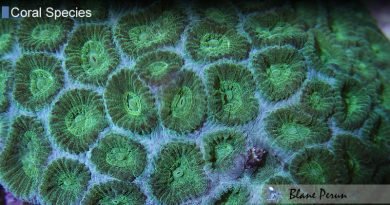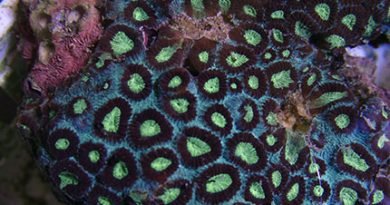Alveopora
Table of Contents
Alveopora, also called branching flowerpot corals, is a genus of stony corals which belongs to the family Portidae. Members of the genus are generally uncommon and they can mostly be found in turbid waters and on steep slopes of the Indo-Pacific region.
Compared to the hard exoskeleton of other hard corals, Alveopora species have a much lighter and softer skeleton. This skeleton is usually light and formed from interconnecting spines or rods. Depending on the species, the colonies might either be massive and compact, or branching resembling the growth of trees. The corallites, which are the hard cups made from the calcium carbonate secreted by the polyps, are generally very perforated, with the septa being formed by fine spines.
The polyps are generally large and of a fleshy consistency. These normally stay extended during the day as well as during the night. The polyps have 12 tentacles which tend to be swollen at the tip, resembling knobs. Just as with most other hard corals, these species live in symbiosis with zooxanthellae, tiny single celled protozoans which provide the corals with organic carbon as well as nitrogen in exchange of nutrients, protection as well as an elevated position needed for these photosynthetic organisms. The color of the polyps largely varies, from pale white to cream, grey or even mixed colors.
There are 27 nominal species in the genus, with 16 of them being labeled true species. The most notable species are A. allingi, A. fenestrate, A. spongiosa and A. viridis. These branching flowerpot corals have large corallites which are usually interconnected. The size of the polyps, which when elongated can reach even 30 centimeters, is the reason for their popular name.
Out of the 16 true species, 8 of them are living in the North, East and West coasts of the Australian continent. Some of the species can be found in the warmer tropical waters of the Pacific Ocean with some even living in the Red Sea.
Just like most other large polyp stony corals, Alveopora species get most of their nutrients from the zooxanthellae they live in symbiosis with. It is estimated that the corals get most of their organic carbon and roughly 90 percent of their energy needs from zooxanthellae, with the remainder being obtained from the column of water, where polyps may absorb dissolved organic matter as well as planktonic organisms.
Branching flowerpot corals can reproduce sexually, as well as asexually. They have both male and female polyps. These release eggs and sperm at the same time, with the fertilization taking place internally. This results in a larvae called planula. After a specific period of time, the planula is released into the water column. The free swimming larvae will eventually settle on the substrate, become a polyp and start excreting a calcium carbonate exoskeleton that will become a new colony. The Alveopora corals can also reproduce asexually through budding, and fragments of the colony can establish a new colony when separated.
Understanding Alveopora: A Dive into the Fascinating World of Coral
Alveopora, a genus of stony corals in the family Poritidae, represents a fascinating and crucial component of our marine ecosystems. This article delves into the unique characteristics, habitat, reproduction, and challenges faced by these corals, providing an informative journey for both the general public and enthusiasts with a background in marine biology.
Alveopora Characteristics: Unveiling the Mysteries
Physical Attributes of Alveopora Corals
Alveopora corals are known for their distinct skeletal structure, often characterized by their porous, lightweight, and calcareous composition. These corals possess a unique arrangement of septa – the radial skeletal elements – that distinguishes them from their close relatives in the Poritidae family. Each polyp of Alveopora is adorned with 12 tentacles, often giving them a soft, feathery appearance. This structure plays a vital role in their feeding and respiration processes, and the variance in coloration, ranging from pale yellows to deep browns, is determined by the symbiotic algae, zooxanthellae, residing within their tissues.
Alveopora’s Habitat and Distribution
Found predominantly in shallow, tropical marine environments, Alveopora corals have adapted to thrive in a range of conditions. Their distribution spans across the Indo-Pacific region, with significant populations in the Great Barrier Reef, the Red Sea, and various Indo-Malay archipelagos. These corals prefer habitats that offer moderate light and water movement, which facilitates their symbiotic relationship with zooxanthellae. Understanding the specific environmental needs of Alveopora is crucial for their conservation and the health of the surrounding marine ecosystem.
Reproduction and Growth in Alveopora
The Reproductive Cycle of Alveopora
Alveopora corals exhibit both sexual and asexual reproduction methods. Sexual reproduction occurs through a process called ‘broadcast spawning,’ where eggs and sperm are released into the water column. This event is typically synchronized with lunar cycles and temperature cues, leading to a spectacular mass spawning event. Asexual reproduction, on the other hand, involves fragmentation, where pieces of the coral break off and develop into new colonies. Both methods play a vital role in the resilience and propagation of Alveopora species in their natural habitats.
Growth Patterns and Rates in Alveopora
The growth rate of Alveopora corals is influenced by several environmental factors, including water temperature, light availability, and nutrient levels. Typically, these corals exhibit a slow growth rate, adding only a few centimeters per year to their size. The skeletal structure of Alveopora, composed mainly of calcium carbonate, develops in a compact, branching form, providing shelter and habitat for a variety of marine life. Understanding their growth patterns is essential for predicting the impact of environmental changes on coral reefs.
Threats and Challenges Facing Alveopora
Environmental Stressors Impacting Alveopora
Alveopora corals, like many other reef-building species, face significant threats from environmental stressors. Climate change, leading to increased sea temperatures and ocean acidification, poses a severe risk to their survival. These conditions can lead to coral bleaching, where the symbiotic algae are expelled, leaving the coral vulnerable and without a vital source of energy. Additionally, pollution and destructive fishing practices further exacerbate the challenges faced by these delicate ecosystems.
Conservation Efforts for Alveopora Survival
Efforts to conserve Alveopora species involve a combination of in-situ and ex-situ strategies. Marine protected areas (MPAs) play a crucial role in safeguarding their natural habitats, while captive breeding and coral gardening initiatives help in replenishing depleted populations. Public education and awareness campaigns are also vital in fostering a sense of stewardship for these vital marine organisms. Conservationists emphasize the importance of reducing carbon footprints and implementing sustainable fishing practices to aid in the preservation of Alveopora corals.
Alveopora in Aquariums and Research
Keeping Alveopora in Home Aquariums
Alveopora corals are a popular choice for marine aquarium enthusiasts, known for their aesthetic appeal and dynamic structure. However, maintaining these corals in home aquariums requires specific conditions that mimic their natural habitat, including appropriate lighting, water flow, and stable water chemistry. Enthusiasts must ensure a balanced symbiosis with zooxanthellae and provide supplemental feeding to keep these corals healthy and thriving in an artificial environment.
Scientific Studies and Discoveries Involving Alveopora
Alveopora has been the subject of numerous scientific studies, focusing on their biology, ecology, and response to environmental changes. Research on their calcification process, resilience to bleaching, and genetic diversity provides valuable insights into their adaptation strategies and the broader implications for coral reef ecosystems. These studies not only contribute to our understanding of Alveopora but also aid in developing effective conservation strategies for coral reefs worldwide.
FAQs About Alveopora
1. What distinguishes Alveopora corals from other coral species? Alveopora corals are distinguished by their unique skeletal structure, with 12 tentacled polyps and a porous, lightweight skeleton. This structure differentiates them from other corals in the Poritidae family and contributes to their distinct appearance.
2. How do Alveopora corals reproduce? Alveopora corals reproduce through both sexual and asexual methods. Sexual reproduction involves broadcast spawning, where eggs and sperm are released into the water, while asexual reproduction occurs through fragmentation, where broken pieces of the coral grow into new colonies.
3. What are the main threats to Alveopora corals? The main threats to Alveopora corals include climate change, leading to increased sea temperatures and ocean acidification, pollution, and destructive fishing practices. These factors contribute to coral bleaching and habitat degradation.
4. Can Alveopora corals be kept in home aquariums? Yes, Alveopora corals can be kept in home aquariums, but they require specific conditions similar to their natural habitat. This includes appropriate lighting, water flow, stable water chemistry, and supplemental feeding.
5. Why are Alveopora corals important to marine ecosystems? Alveopora corals play a crucial role in marine ecosystems by providing habitat and shelter for various marine species, contributing to the biodiversity of coral reefs. They also play a part in the nutrient cycle and help in the formation of reef structures.




